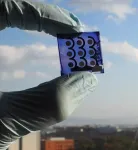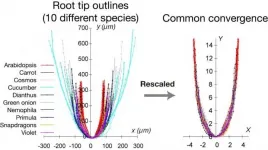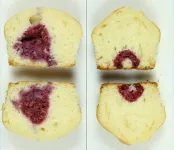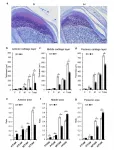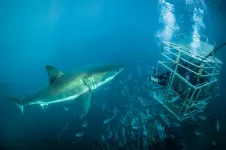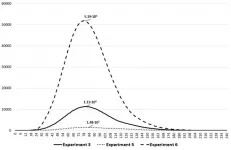RUDN University professor suggested how to calculate the implant materials permeability
2021-03-01
(Press-News.org) An associate professor from RUDN University found out the effect of the number and size of pores on the permeability of bone implants by biological fluids. The results of the study could help choose the optimal physical parameters of implants. The results of the study were published in the International Journal of Engineering.
For an implant to survive in the body and to take the place of bone tissue, it should be made of a non-toxic, biologically inert, and wearproof material. However, at the same time, it should be light, porous, and permeable by biological liquids. If an implant does not interfere with the transfer of oxygen, minerals, and nutrients, new bone tissue and blood vessels start to grow around it, and a patient's regeneration is more successful. However, it is still unclear what level of porosity secures the best permeability and bone restoration. An engineer from RUDN University was the first to carry out a numerical simulation of these characteristics and to provide a quantitative evaluation of the correlation between porosity and permeability.
"The internal structure of implant material is as important for bone reconstruction as its biocompatibility. It is still unknown whether the process of bone tissue regeneration depends on implant porosity and whether it affects permeability. The results of experimental studies of this issue are unclear. A model of the material structure allows us to simulate the processes that an implant undergoes in a body and to evaluate the importance of its parameters in quantitative terms," said Kazem Reza Kasyzadeh, an associate professor at the Department of Mechanical and Instrumental Engineering of the Engineering Academy, RUDN University.
The team used a 3D printer to create two groups of structures made of identical cubic cells with a plane length of 1.8 mm in the first group and 2 mm in the second one. Then, three cylinder-shaped objects (8 mm high and 14 mm in diameter) were added to each group. The levels of porosity in them varied from 34% to 72%, and the pores were 0.8 to 1.3 mm in diameter in the first group and 0.9 to 1.5 mm in the second one. To test their permeability, the engineers used three water and glycerin mixtures with different density and viscosity levels. Then, the team modeled the flow of liquids and their pressure on the porous structures of the implants at different rates. After that, the scientists calculated the permeability coefficient of each structure based on the models. Although the calculations failed to match the experimental data, they followed the same trend: the higher the porosity, the more permeable are the materials. Permeability also correlated with the size of the pores: a 20% diameter reduction led to a 76% decrease of permeability.
"Potentially, our results could help reduce the number of experimental tests of new bone implant structures. We managed to confirm that both the number of pores in a structure and their size affect material permeability. Therefore, if the mechanical properties of a material permit it, its permeability could be increased by means of changing the pore size while keeping its porosity on the same level," added Kazem Reza Kashyzadeh from RUDN University.
INFORMATION:
[Attachments] See images for this press release:
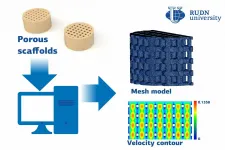
ELSE PRESS RELEASES FROM THIS DATE:
2021-03-01
Osaka, Japan - Osaka University researchers employed machine learning to design new polymers for use in photovoltaic devices. After virtually screening over 200,000 candidate materials, they synthesized one of the most promising and found its properties were consistent with their predictions. This work may lead to a revolution in the way functional materials are discovered.
Machine learning is a powerful tool that allows computers to make predictions about even complex situations, as long as the algorithms are supplied with sufficient example data. This is especially useful for complicated ...
2021-03-01
With their exuberant colours, fiery personalities and captivating courtship displays, the fairy wrasses are one of the most beloved coral reef fish. Despite this, the evolutionary history of its genus was not well understood - until now.
Fairy wrasses diverged in form and colour after repeated sea level rises and falls during the last ice age, finds a new study. Published in top journal Systematic Biology, it employed a novel genome-wide dataset to make this discovery.
Lead author, ichthyologist and PhD candidate at the University of Sydney, Mr Yi-Kai (Kai) Tea, says ...
2021-03-01
Osaka, Japan - Nature is full of diversity, but underneath the differences are often shared features. Researchers from Japan investigating diversity in plant features have discovered that plant root tips commonly converged to a particular shape because of physical restrictions on their growth.
In a study published in February in Development, researchers from Osaka University, Nara Institute of Science and Technology, and Kobe University have revealed that plant root tips are constrained to a dome-shaped outline because of restrictions on their tissue growth. This study is one of the papers selected as a Research Highlight published in this issue of Development ...
2021-03-01
Raspberry muffins are in our future.
Washington State University scientists have figured out a way to treat raspberries before they're frozen so that they maintain their structure when thawed.
The tart little berries are very delicate and freezing damages their cells. They turn to mush when baked and leak juice into the surrounding baked product, making them unattractive and diluted in flavor. As a result, frozen raspberries are rarely used in baking, whether at home or in commercial bakeries. But that's about to change.
In a recent article published in Food and Bioprocess ...
2021-03-01
Making cheese leaves a lot to chance as a batch could be ripened for months or even years before a problem is discovered, which could send a prized batch of cheddar to be sold off cheap as an ingredient for processed cheese.
It's part of why cheese is so complex and expensive to make - a factory could invest lots of time and money into what they think will be a top-graded batch, only to discover it's a flop when it's too late to fix.
But new research from RMIT University in Melbourne, Australia allows quality to be checked much earlier and more precisely in the process, giving manufacturers a better chance to react to issues with the ripening process.
Dr ...
2021-03-01
Researchers from Tokyo Medical and Dental University (TMDU) observe underdeveloped jaw cartilage in newborn rats exposed to periods of low oxygen
Tokyo, Japan - Breathing in adequate amounts of oxygen is critical for human life. However, certain disorders can cause individuals to go through periods where they are exposed to periodical low levels of oxygen, called intermittent hypoxia (IH). This is common in people who suffer from some sleep disorders like obstructive sleep apnea. Although we know IH can cause neurological development issues, it is not clear how it affects cartilage. Now, researchers at Tokyo Medical and Dental University (TMDU) have shown that IH can result in underdeveloped jaw cartilage in rats.
In an article published in Scientific Reports, researchers ...
2021-03-01
HIV infections are treated with antiviral drugs which effectively prevent the disease from developing. While pharmacological HIV therapy has advanced considerably, the virus cannot be entirely eliminated from the body with currently available drugs.
However, in roughly one-fifth of HIV patients the immune system does not recover as expected: the quantity of CD4 T cells, reflecting the status of the immune system, remains low even when the quantity of HI viruses in blood is suppressed to very low levels or below the measurement threshold. In such patients, indications of chronic immune activation, which erodes the immune system, can be detected.
In cooperation with the University of Erlangen-Nuremberg in Germany, researchers at the University of Helsinki have ...
2021-03-01
Wildlife tourism including white shark cage-diving is growing in popularity, but these industries remain highly contentious amongst tourists, conservationists, and scientists alike.
Many voice concerns about possible negative impacts - especially when it targets potentially dangerous animals - while proponents cite the socio-economic benefits to justify wildlife tourism activities.
In reality, wildlife tourism is complex, requiring managers to balance the benefits and drawbacks to determine what is acceptable for such industries.
To help solve this question of "is wildlife tourism good or bad?", a tool to help managers assess these industries has been created ...
2021-03-01
A painful tradeoff between a number of infected and negative economic impact must be considered before deciding on the lockdown strategy within a city. As national economies continue to crumble, citizens wonder whether their governments did a good job at regulating the lockdown measures.
Russian city of St. Petersburg is at the frontlines of this ongoing war with Covid-19. To combat this situation effectively, Russian government allocated significant funds for the research. Results followed. Scientists from Peter the Great St.Petersburg Polytechnic University (SPbPU) modified the existing SIR class pandemic prediction model. Now it is better.
But why? What is the nature ...
2021-03-01
Breast cancer is the commonest fatal cancer in women. Early detection increases a woman's chances of recovery. Magnetic Resonance Imaging (MRI) is an accurate technique for detecting and classifying tumours in breast tissue. However, it sometimes causes "false alarms", thus requiring further investigation (biopsy) and in some cases even resulting in so-called overtreatment, that is to say unnecessary surgery. For the first time, a research team from MedUni Vienna has now confirmed a threshold value for a non-invasive imaging biomarker. This can be incorporated into short standard MRI scans ...
LAST 30 PRESS RELEASES:
[Press-News.org] RUDN University professor suggested how to calculate the implant materials permeability

